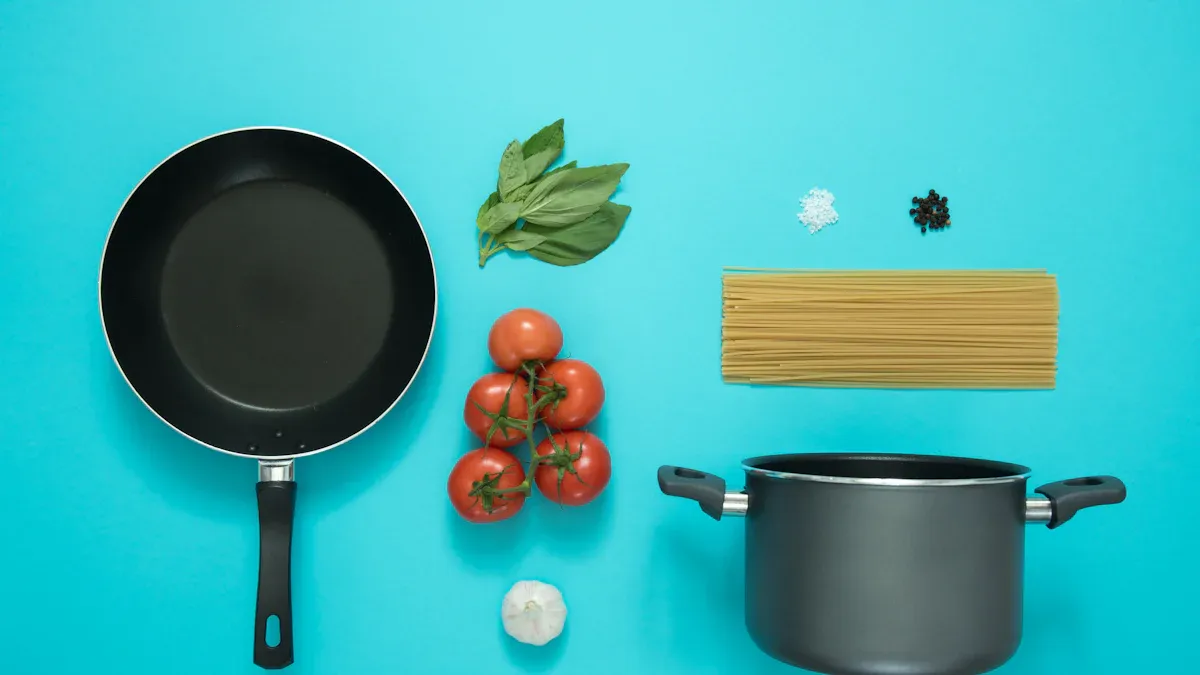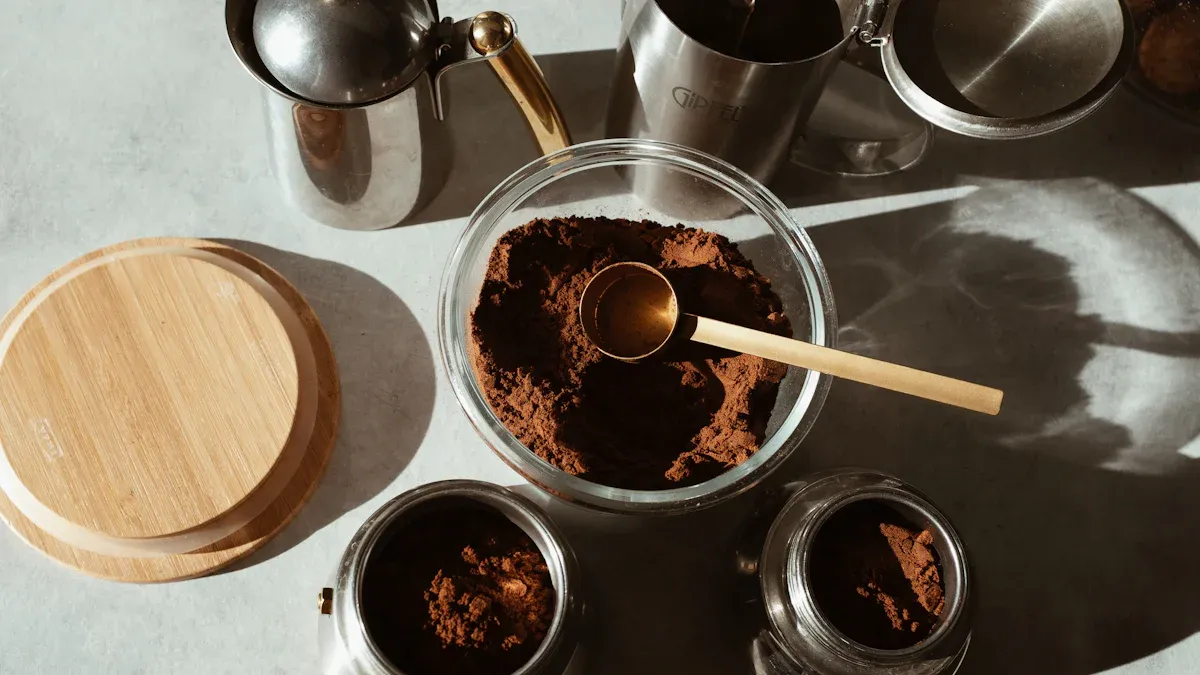
Aka nri omenala na-arụ ọrụ dị ịrịba ama na enyere akara zuru ụwa ọnụ zute ihe ndị na-azụ ahịa dị iche iche. Akụkụ ndị a ọ bụghị naanị na arụmọrụ kamakwa ahazi ya na nkọwa pụrụ iche nke OEM / ODM. Mkpa ha dị mkpa pụtara ìhè mgbe ha na-atụle ahịa coodware zuru ụwa ọnụ, iji ruo ijeri $ 30.59 na 2023.
- Na-arị elu maka nri nwere nri dị na ECO-enyi na-eme ka ọ dị mkpa maka njikwa njikwa.
Customization offers brands a competitive edge by addressing specific consumer preferences. Dịka ọmụmaatụ, ndị na-emepụta OEM / ODM / ODM na-enye edozi edozi aha na mkpa dị iche iche na mkpa ndị ergonomic pụrụ iche, na-ejide na ndị nọ n'ọhịa ndị mmadụ juru.
Ihu na-aga
- Special cookware handles improve use and meet different customer needs. Ha na-enyere aka na-asọmpi na-asọmpi nke ọma n'ahịa.
- Iji ihe akwụkwọ ndụ akwụkwọ ndụ na ihe ndị nwere enyi na enyi dị mkpa ugbu a. Ndị mmadụ chọrọ ngwaahịa ndị dị mma maka gburugburu ebe obibi.
- Comfortable designs make handles safer and easier to use. Nke a na-adọta ndị na-azụ ahịa na-eche banyere ahụike na nchekwa.
- Usoro nhazi omenala nwere ike imetụta ihe ndị mmadụ na-azụta. Nke a na-enyere aka ịzụlite ntụkwasị obi ma mee ka ndị ahịa guzosie ike.
Usoro nhazi
Meeting OEM/ODM requirements involves addressing diverse customization needs to cater to global markets. Ihe ndị pụrụ iche na atụmatụ ọhụụ na-eme ka arụ ọrụ ma na-amasị ndị ahịa ahịa ụfọdụ akọwapụtara. Dị ka ọmụmaatụ:
- Ekike siri ike ma sie ike maka onye ahịa Middle Ealice ghọrọ onye na-eme ka ọ bụrụ ihe ndabere maka ndakọrịta ya na ngwa ngwa Italiantali dị arọ.
- Ihe dị mgbagwoju anya metal na-eji akwa igwe anaghị agba nchara na achịcha maka onye ahịa Spanish nwetara ọkwa n'agbanyeghi ụgwọ ọrụ dị elu.
A na-ejikarị ejiji na-abụghị nkọ na-arịwanye elu n'etiti ndị na-azụ ahịa ahụ ike. Ọzọkwa, ihe ndị dị ka silicone na ọla gbanyere mkpọrọgwụ na-enweta traction ka mmata gburugburu ebe obibi na-eto. Omume ndị a na-egosi mkpa ọ dị inye azịza ha ga-ezute ihe ahịa ahịa.
Ụkpụrụ dị mma
High-quality standards are essential for custom cookware handles to ensure durability and safety. Manufacturers must comply with industry benchmarks, such as EN 12983-1 and ISO 9001, which certify heat resistance, strength, and performance. Tebụl dị n'okpuru ebe a na-edepụta ihe ndị dị mkpa na uru ha:
| Mgwooru | Uru | Inwe nnabata |
|---|---|---|
| Thermoset plastik | Iguzogide okpomoku | |
| Igwe anaghị agba nchara | Ọdịdị siri ike, ezigbo ike | ISO 9001 |
| Ireke | Ike, arụmọrụ | |
| Silicone | Na-enweghị eriri | ISO 9001 |
Tupu mwepụta ahịa, ngwakọta cilings na-eme nnwale siri ike iji nyochaa onye ọrụ na ịdịte aka na nchekasị. Ndị na-emepụta ihe na-ahụkwa na ha na-enwe nchegharị ọkụ site na nkume na shei. Ihe ndị a na-eme ihe na-ekwe nkwa ngwaahịa na-ezute ma atụmanya ndị ahịa na usoro nhazi.

Nhọrọ Ngwa
| Standadi | Nkowa |
|---|---|
| Na-ahụ na nguzogide okpomọkụ na ogologo nke aka | |
| ISO 9001 |
Ergonomic imewe
Akara aka Ergonomic na-eme ka nkwalite na nkasi obi dị mma, na-agwa mkpa nke ndị na-azụ ahịa dị iche iche. Njikwa kwụsiri ike na nke iru ala dị mkpa, dị ka aka dị ka ihe isi ike dị n'etiti ndị ọrụ na nri. Ndị na-emepụta ihe na-elekwasị anya na akụkụ kachasị mma na oke iji gbochie ahụ erughị ala n'oge ojiji.
Ndị na-ese ihe na-atụtakwa ịdị ọcha na nchekwa. Atụmatụ dị ka mkpuchi mkpuchi na-eme ka agbasa nje, ebe ọ bụ na-enweghị ndọtị na-enweghị ike ịkwasi ike. Observations of user interactions with kitchen tools inform these design decisions, ensuring handles accommodate various hand sizes and minimize strain. Nkwalite ergonomic ndị a ọ bụghị naanị imeziwanye arụmọrụ kamakwa emetụta mkpebi ịzụrụ.
Color and finish customization allows brands to align cookware handles with their unique identity. A variety of colors and high-quality coatings are available, enabling manufacturers to create visually appealing products. Dị ka ihe atụ, na-enweghị mpịakọta, na-eme ka a na-arụ ọrụ ma ọlị.
Ihe eji eme ihe na-arụ ọrụ dị oke mkpa n'iwelite mkpesa na ahịa ahịa nke ngwaike Cool. Ihe ndị a ọ bụghị naanị ịkwalite njirimara nke ngwaahịa mana na-ekwusa atụmatụ ya pụrụ iche na mma maka ndị na-azụ ahịa. Manufacturers often incorporate branding through logos, embossed designs, or laser engravings on handles, ensuring that cookware aligns with the brand's identity and values.
Effective branding strategies can significantly influence consumer decisions. Dị ka ọmụmaatụ:
- Ntụgharị na Asambodo dị ka ISO 9001 ma ọ bụ EN 12983-1 na-agwa ndị na-azụ ahịa nke nchekwa ngwaahịa na ịdịte aka.
Omume ndị a abụghị naanị ịzụlite ntụkwasị obi kamakwa imepụta echiche nke ntụkwasị obi, nke dị mkpa na ahịa asọmpi.
Agba na imecha nhazi ọzọ iji nweta ohere. Ejiri aka na atụmatụ agba pụrụ iche ma ọ bụ nke premium na-emecha, dị ka matte ma ọ bụ ederede na-acha uhie uhie, nwere ike igosipụta ụdị onye ọ bụla. Iji maa atụ, otu ihe eji eme nri nwere ike ịpụ maka ụcha na-acha, ebe ụma mara mma nwere ike ịmasị metallic metallic meriri. These choices ensure that the product resonates with its target demographic.
Ọzọkwa, ntinye ihe nwere ike ịgbatị na nkwakọ ngwaahịa na nkwalite. Ihe ngwugwu a haziri nke ọma na-egosiputa atụmatụ na asambodo nwere ike ịhapụ echiche na-adịgide adịgide na ndị ahịa. By integrating branding into every aspect of the product, manufacturers help global brands establish a strong presence in the market.
Usoro ịkpata maka ngwakọta cilings omenala
Injinia
Material selection also influences precision. Stainless steel and Bakelite, for instance, require different machining techniques due to their unique properties. Ndị injinia jiri ngwa na-eme ka ihe dị iche iche nabata ọdịiche ndị a, na-enweta nsonaazụ kachasị mma. By prioritizing precision, manufacturers deliver handles that meet stringent OEM/ODM requirements and enhance user experience.
Skaparami
Njikwa Dị Mma
Quality control safeguards the integrity of custom cookware handles. Manufacturers implement rigorous testing protocols to ensure products meet industry standards and consumer expectations. Ule na-enyocha nguzogide okpomọkụ, ịdịte aka na arụmọrụ ergonomic n'okpuru ọnọdụ dị iche iche.
Certifications like ISO 9001 and EN 12983-1 validate the quality of handles, reassuring clients of their reliability. Nnyocha nyocha na nyocha akpaghị aka na-achọpụta ntụpọ n'oge mmepụta, belata mkpofu ma na-agba mbọ na-enweghị ngwaahịa na-enweghị ntụpọ na-erute ahịa. By prioritizing quality control, manufacturers uphold their reputation and build trust with global brands.
Nkwado na Cookware Omenala

Ihe eji eme enyi
Ojiji nke ihe eji eme ihe n'emeputa ihe eji eme ihe eji eme ihe eji eme ihe bu ihe diri otutu udiri. Ndị na-emepụta ihe ugbu a na-elekwasị anya ugbu a na itinye ihe na-agbanwe agbanwe na ihe ndị sitere na ihe sitere n'okike dị na ya. Ihe ndị a belata ntụkwasị obi na kemịkal dị egwu ma belata mmetụta gburugburu ebe obibi. Mmakọ na-eto eto nke ihe ndị na-eme ihe na-abawanye uru maka ngwaahịa maka gburugburu ebe obibi.
For instance, some manufacturers have developed sustainable cookware lines that utilize natural materials to lower resource consumption and emissions. Akụkụ a na-aga n'ihu na ụkpụrụ zuru ụwa ọnụ ma na-enyere anyị aka inwe nnabata ụkpụrụ ụlọ ọrụ. By adopting eco-friendly materials, manufacturers not only meet consumer expectations but also contribute to long-term environmental benefits.
Energy-efficient manufacturing processes play a crucial role in reducing the carbon footprint of cookware handle production. Ugbu a dị ka sistemụ arụmọrụ na igwe na-echekwa ike, na-ebulikwa itinye aka na mkpofu ike. These innovations allow manufacturers to maintain high production standards while lowering operational costs.
Iji maa atụ, ihe eji eme ihe eji arụ ọrụ nke ọma nwere ike iwepụta nnukwu mpịakọta nke aka cookware na-enweghị imebi àgwà. Arụ ọrụ a na-akwado scalability ma na-eme ka ndị na-emepụta mezuo ihe nke ụdị ụwa zuru ụwa ọnụ. By prioritizing energy-efficient practices, companies demonstrate their commitment to sustainability and strengthen their reputation in the market.
Ibelata ihe mkpofu n'oge mmepụta dị mkpa maka nrụpụta. Ndị na-emepụta ihe na-eme ka ihe dị ka ihe nrịba ama ma na-eme ka usoro mmepụta iji belata mkpofu ahihia. These efforts not only lower environmental impact but also improve cost efficiency.
have become indispensable for global brands aiming to meet OEM/ODM requirements. Their ability to align with specific brand needs ensures products resonate with diverse consumer preferences. Injinia na-eme ihe ngosi na-enweghị ntụpọ, ebe usoro mmepụta na-eme ka ị na-enyere ndị na-emepụta ihe iji zute ngwa ngwa ngwa ngwa. Sustainability initiatives, such as eco-friendly materials and energy-efficient manufacturing, further enhance their appeal in an environmentally conscious market.
Customization continues to drive global competitiveness. Ọmụmaatụ:
Ajụjụ
Ndị na-emepụta ihe na-eji ihe dị ka igwe anaghị agba nchara, ndị na-ere ahịa, na Silicone. Igwe anaghị agba nchara na-enye ike na nke dị elu. A na-eme ka ihe dị ike na ịdị ogologo. Silicone ensures a non-slip grip and heat resistance, making it ideal for safety-conscious consumers.
Yes, manufacturers offer branding options such as embossed logos, laser engravings, and unique color schemes. Ihe ndị a na - emekọ ọnụ na njirimara nke eji eme ya, mee ka a na - ere ahịa na nnabata azụmaahịa.
Ihe eji eme ihe eji eme nri?
Akụrụngwa nwere omume enyi dị ka ọla megharịrị ma na-arị elu na-ewu ewu. Nhọrọ ndị a belata mmetụta gburugburu ebe obibi ka ịnọgide na-enwe agụụ na arụmọrụ, na-ezute na-etolite na-achọ ihe ngwọta nri.
Olee ọrụ ergonomic imewe arụ ọrụ na ejiri aka nri?
Ergonomic chepụta ihe na nchekwa ọrụ. Atụmatụ dị ka nri na-enweghị isi na mkpuchi mgbochi na-enweghị atụ. Ndị na-emepụta na-ebulikwa akụkụ dịgasị iche iche nha, na-ejide ahụmịhe siri ike na ntụsara ahụ.
Oge post: Mar-18-2025
